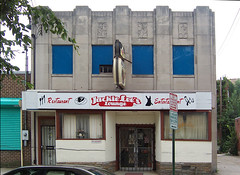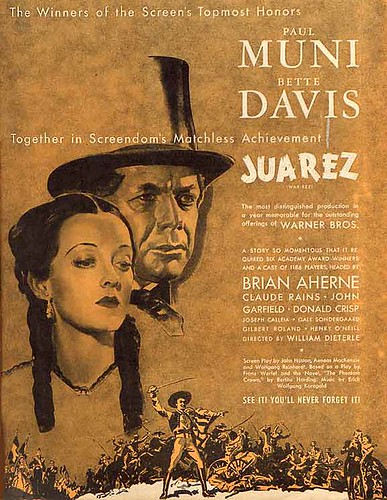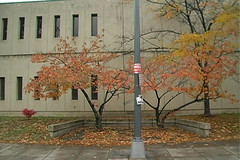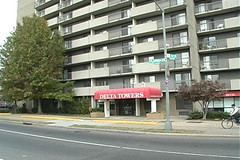Who can you turn to when the most active, aggressive destroyers of the city's livable places are DC Government agencies?
Over the weekend, local preservation activist Peter Sefton alerted a group of us that you might consider the "triage" or "emergency room doctors" of preservation about an impending demolition of some great buildings on Kennedy Street NW, centered around the Kennedy Theater.
 Kennedy Theater, Kennedy Street NW Washington, DC. Photo by Peter Sefton.
Kennedy Theater, Kennedy Street NW Washington, DC. Photo by Peter Sefton. Adjoining Buildings. Jackie Lee Lounge 116 Kennedy Street NW. Photo by Peter Sefton. This building is not under threat of demolition but is an example of the buildings an 1930s Art Deco era Historic District could include. The Kennedy Theatre is not itself Art Deco but is of the era even if retro.
Adjoining Buildings. Jackie Lee Lounge 116 Kennedy Street NW. Photo by Peter Sefton. This building is not under threat of demolition but is an example of the buildings an 1930s Art Deco era Historic District could include. The Kennedy Theatre is not itself Art Deco but is of the era even if retro.1. Peter Sefton wrote:
There is a recent application to demolish the Kennedy Theatre and an adjacent block of storefronts.
Located at 326 Kennedy Street NW, the Kennedy Theatre is one of Washington’s most elegant neighborhood movie houses. Designed by noted New York theatre architect John Ebersole for Warner Brothers, the Kennedy opened on June 15, 1939 with a showing of “Juarez” starring Bettie Davis and Paul Muni. Besides its handsome faacade and air-conditioning, the 1000 seat theatre was noted for its décor, “dominated by blues and terra cotta, with the side walls in deep figured blue tapestry and the proscenium and grill drapes in harmonious autumn tone.”

The Kennedy showed movies into the early 1980s and then served as a church. Both the theatre and adjacent storefronts are vacant, but appear in sound condition from the sidewalk.
But there is actually more at stake here than the Kennedy Commercial Block. The nearby blocks of Kennedy Street NW have a wealth of Art Deco commercial buildings, including one set of storefronts designed by Julius Wenig. I am thinking that this strip is intact enough to become a mini-historic district if we can save its centerpiece.
But we have only 20 days before the permit can be issued!
2. Of course, I wrote that I'm in, that it is important to retain these kinds of commercial buildings (I am particularly enamored of old movie theaters), and that time is of the essence.
3. The first semi-official DC Preservation League board member response was this:
This raises a serious issue. We do not want to landmark buildings on the fly. It’s too significant an impact on owners and the community and it can devalue the meaning of “landmark”. We need to have in place serious criteria for landmarking and we need to develop with the HPO some kind of process to avoid crisis reaction.
4. I bristled at this, because the City of Washington lacks a comprehensive building by building survey of resources to begin with. The criteria are known, and we have no choice but to respond out of crisis.
I wrote (in response to one of the leading architects in the city):
This is a bullshit argument.
Speaking as a preservation advocate who is not yet academically credentialed, I would argue that there are two basic levels of consideration for historic designation. One has to do with buildings of a high level of significance, i.e., George Washington slept here; Colden Florence designed it; Malcolm X was shot here; Rosa Parks made her stand here; John F. Kennedy had sex there; etc. Although you know the criteria better than I; the criteria can be met by significance "not quite" at this level of example.
________________
Criteria for Evaluation (from the National Register of Historic Places website)**
The quality of significance in American history, architecture, archeology, engineering, and culture is present in districts, sites, buildings, structures, and objects that possess integrity of location, design, setting, materials, workmanship, feeling, and association, and:
A. That are associated with events that have made a significant contribution to the broad patterns of our history; or
B. That are associated with the lives of persons significant in our past; or
C. That embody the distinctive characteristics of a type, period, or method of construction, or that represent the work of a master, or that possess high artistic values, or that represent a significant and distinguishable entity whose components may lack individual distinction; or
D. That have yielded or may be likely to yield, information important in prehistory or history.
** Note: this wasn't included in the original email. Usually Criterion C covers the creation of historic districts. The criteria used in DC are slightly different, but derive from the NR criteria.
________________________
The other is the preservation of the nexus of place, architecture, and social, cultural, and/or economic history. This as you know is the basic justification of the creation of neighborhood historic districts. The average building in such a district doesn't merit designation on its own. What matters is the power and beauty and coherence of the whole.
This particular set of buildings is significant in terms of the second basic thrust.
Your argument would have some weight if the City of Washington had in fact conducted a comprehensive survey of all potential resources in the city. It has not. Which you know as well as anybody.
Until that is done so (and do I see you and others strenuously advocating for such?-I do, and I raise this issue all the time), landmark nominations of the sort proposed by Peter Sefton are the only strategy that we have for preserving urban history, particularly at the neighborhood level.
Frankly, this block and the buildings would be contributing as part of either of two different types of thematic surveys that could be performed: (1) cinemas and theaters; (2) the development of neighborhood commercial districts in the City of Washington.
[Thematic surveys are surveys and nominations of "types" of buildings/resources, rather than of individual buildings (significant "landmarks") or districts such as neighborhood historic districts, and are covered under what is called a "Multiple Property Nomination."]
Neither such survey could be turned around in 18 days.
It's called triage. And it's what we are forced to do in an environment that has no proactive historic preservation policy and strategy--in short, we must be reactive.
A meeting in a couple weeks, and hashing out "a policy" over the next few months doesn't cut it
5. Well the response to that was a throwing oil on the waters email from a high level official in the DC Historic Preservation Office. We learned from the email that the "demolisher" is in fact a District Government agency, the DC Office on Aging, and that the Historic Preservation Office has already signed off on this project. That OA had wanted to tear everything down and getting them to agree to save the the facades should be seen as a great victory since they had intended to tear down everything.
The email said that the HPO learned about this project as part of the negotiations over the Hayes School in NE DC.
OA bought Hayes School. They wanted to tear it down, or just save the southern and western elevations of the buildings, but various people, I guess including me, helped stop that from happening. The real lesson is that the Office of Aging shouldn't buy buildings that aren't necessarily appropriate to their needs, and then butcher the buildings to get what they want.
6. Peter Sefton wrote in response to a couple other emails (edited):
While ideally we should work to a plan, I cannot agree that preservationists have an obligation to be psychics. Even if we work ahead, we do not set developers’ agendae and cannot protect every worthy building in advance of a threat. DCPL was born as “Don’t Tear It Down” in a crisis and the day that we shy away from a worthy battle because it wasn’t on our agenda is the day we become irrelevant.
7. My response to the news from HPO:
As you know I am happy to be hardcore on this. However, I will make one point, if these buildings are owned by the DC Government, and if these buildings are covered by an agreement with the DC SHPO, we can file a landmark nomination, but we are likely to get "screwed".
By this I mean that we will do a lot of work (a couple hundred hours over the next couple weeks and in preparation for a hearing).
This is a lot of work to put in when there is a likelihood of almost certain failure to achieve designation. OTOH, it would be hard for DC HPO to write a staff report that would assert that the buildings aren't worthy of protection. Although I suppose they could hire Traceries to get such a finding...
Nonetheless, I am not sure that HPRB would go counter to something that HPO has already signed off on.
Getting back to my general theme of transparency and citizen involvement in more of these processes, I guess I would argue that if concerned citizens/preservation organizations outside of the city government had been involved in this process, that (1) we wouldn't be chomping at the bit to file a nomination now and (2) that a better result could have been achieved than that which has currently been obtained.
I make this last point based on my perceptions as an advocate, and experience working for a national advocacy organization with direct Nader lineage.
It's advocates job to advocate. It's a government agency's job to negotiate and "be reasonable."
With hard core advocacy in the mix, you get a result closer to the ideal.
When you cave early, in the spirit of "negotiation," the final results can be seriously compromised.
WRT Peter's point, I agree that "we should work to a plan," but such a plan starts with a systematic survey of all potential resources, and with building the infrastructure and capacity of community organizations to deal with preservation (and urban design) issues both at the neighborhood-level and city-wide.
Until such happens, triage rules. And the first priority of preservationists should be to preserve.
8. Well, there was some more back and forth, and I know that much of the e-thread has been sent to the Board of DC Preservation League, and this is what I wrote on Tuesday:
Given the city's involvement already, it's not likely that a nomination could be sustained, so it's not likely we'll file a nomination.
Nonetheless, it is extremely troubling that DC Government agencies are active and aggressive destroyers of the city's livable places. DCOA is hardly the only agency--the school system, libraries, DPR--all have constructed buildings or designed sites that have contravened many or most of the principles of urban design, and that are disconnected from the context and the neighborhood surrounding. The quality of life in our neighborhoods is being diminished year-by-year as such practices continue. (Anybody seen the Sherwood Recreation Center?)
Certainly, the comprehensive plan revision process hasn't convinced me that we will do a better job in the future.
As long as the "negotiations" for actions such as the plan for the "renovation" of the Kennedy Theater and adjacent commercial buildings happens behind closed doors, it's more likely than not that serious compromises will occur, compromises that are likely to dis-serve historic preservation and the quality of life of District citizens and neighborhoods.
I ask that you remember that we are the stewards of the places that have been left to us. Perhaps we are fortunate that "back then" society and government cared about such things as quality of life and beautiful architecture.
In the days of value engineering and throw-away culture, it's easy to see what we've lost. From City Beautiful to Urban Brutalism in a few decades is a difficult change to grasp and to accept. Perhaps the buildings that various government agencies are yielding today aren't quite as brutal as the Watha T. Daniel Public Library on Rhode Island Avenue NW, but they are no less destructive to the goal of stabilizing, maintaining, and extending the qualities of livable places in our neighborhoods and in the city as a whole. The Watha T. Daniel Public Library Branch is a perfect example of how DC Government building projects destroy neighborhoods rather than catalyze improvement. This is true of most city building projects, including many created by the city's community development corporations, most every school and health facility built since the 1950s and virtually all urban renewal projects across the city such as Hechinger Mall and senior housing buildings like Delta Towers.
The Watha T. Daniel Public Library Branch is a perfect example of how DC Government building projects destroy neighborhoods rather than catalyze improvement. This is true of most city building projects, including many created by the city's community development corporations, most every school and health facility built since the 1950s and virtually all urban renewal projects across the city such as Hechinger Mall and senior housing buildings like Delta Towers. Delta Towers, 1400 block of Florida Avenue, NE, Washington, DC.
Delta Towers, 1400 block of Florida Avenue, NE, Washington, DC.
Don Rypkema tells a story about working with his father, who was in the cattle industry. He said the point about improving the herd was to never buy a cow or bull that performed less than the average of the herd, that to improve the herd overall you have to be choosy and make hard choices and get "better" animals.
He then points out that it's the same with buildings and that if a new building proposed isn't better than the current average, it diminishes, substantively, the quality of the built environment. We know that in most cases, the historic building is in fact "better" in terms of design, longevity, and contribution to the quality of life and beauty in the city.
Given that the District's "competitive advantage" is its architecture and history, diminishing this architecture and history through wanton destruction of historic buildings is bad policy and bad strategy.
Think about the built environment that we are leaving as our legacy to the future.
9. What should we do? There are two weeks left.
As I pointed out in another email, there is no way that these buildings wouldn't be deemed worthy of designation, based on decisions in favor of designating both the Atlas Theater and the H Street Playhouse (once the Plymouth Theater, created by the operator of the Pix Theater--now the National Museum of Women in the Arts--to serve African-American audiences).
Why isn't there a thematic survey of DC cinemas and theaters?
Why isn't there a thematic survey of DC neighborhood commercial districts?
Why aren't there interim protections and procedures beyond triage for signficant protection of the city's cultural resources, when these are the architectural resources that define our neighborhoods and the city as a whole?



0 Comments:
Post a Comment
<< Home